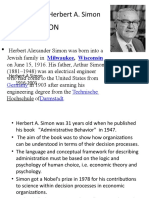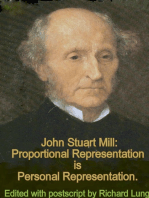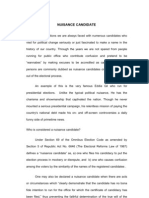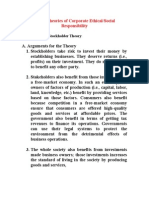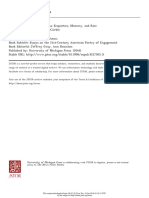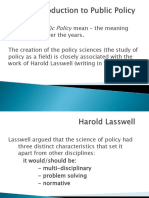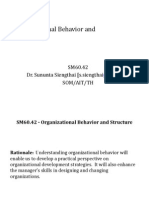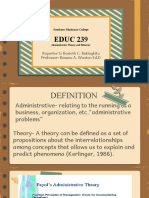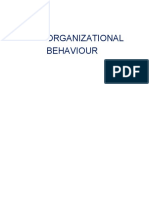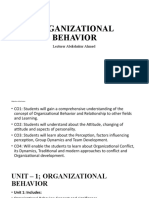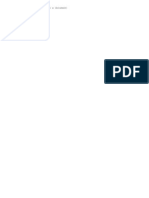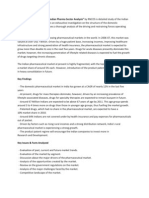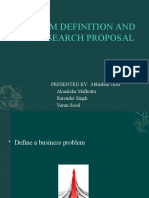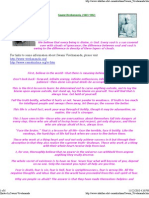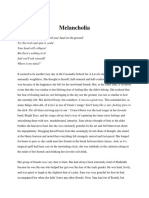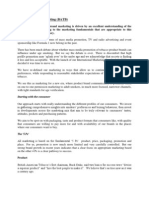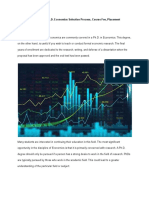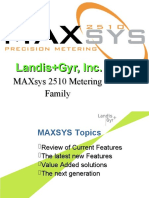Professional Documents
Culture Documents
Herbert A. Simon: - Introduction
Uploaded by
Surender Arya0 ratings0% found this document useful (0 votes)
542 views19 pagesOriginal Title
Herbert Simon
Copyright
© Attribution Non-Commercial (BY-NC)
Available Formats
PPTX, PDF, TXT or read online from Scribd
Share this document
Did you find this document useful?
Is this content inappropriate?
Report this DocumentCopyright:
Attribution Non-Commercial (BY-NC)
Available Formats
Download as PPTX, PDF, TXT or read online from Scribd
0 ratings0% found this document useful (0 votes)
542 views19 pagesHerbert A. Simon: - Introduction
Uploaded by
Surender AryaCopyright:
Attribution Non-Commercial (BY-NC)
Available Formats
Download as PPTX, PDF, TXT or read online from Scribd
You are on page 1of 19
Herbert A.
Simon
• INTRODUCTION
• Herbert Alexander Simon was born into a
Jewish family in Milwaukee, Wisconsin
on June 15, 1916. His father, Arthur Simon
(1881–1948) was an electrical engineer
Herbert A.Simon
who had come to the United States from
1916-20011903 after earning his
Germany in
engineering degree from the Technische
Hochschule ofDarmstadt.
• Herbert A. Simon was 31 years old when he published
his book "Administrative Behavior" in 1947.
• The aim of the book was to show how organizations
can be understood in terms of their decision processes.
• The language and conceptual framework for describing
administration must be based on the logic and
psychology of human choice, i.e. economic theory and
psychology.
• Simon got a Nobel's prize in 1978 for his contributions
to science within decision processes in economic
organizations.
• His book, "Administrative Behavior", was emphasized
in particular (Bakka and Fivesdal,) .
Books
1. Measuring Munciple Activities in co
authorships with Clarence Ridley.
2. Administrative Behaviour
3. Public Administrative
4. Organisation: in co authorship with James
G. March .
5. The New Science of Management Dicision
The following conclusion from his book “administration Behaviour “ are
worth recording:
The Organisation
1) a specialization of the organization according to
purpose, process, cliental (customers), or place;
2) arranging the organization in a determinate
hierarchy of authority;
3) limiting the span of control at any given point in
the hierarchy to a small number.
• How does the organization fit the individuals behavior into an overall
pattern ?
• How does it establish and maintain the premises that influences his
decisions?
• Simon distinguish between two principal sets of mechanisms or
aspects of influence
external and
internal:
• External mechanisms are the stimuli with which the organization
seeks to influence the individual. those that initiate behavior in
a particular direction.
• Internal mechanisms are those which determines his response the
stimuli. those that cause behavior to persist in a particular direction
once it has been turned in that direction.
DECISION MAKING
• Simons definition for a strategy is as follows: "Decision,
or choice, is the process by which one of [the]
alternatives for each moment's behavior is selected to
be carried out.
• The series of such decisions which determines behavior
over some stretch of time may be called a strategy.
• Simon, Administrative Behavior,
- You will always choose the alternative which is highest
on your value-scale (maximization).
- You will always make the same choice if/when the
situation recur.
Model of Dicision making.
According to him, the dicision process can be broken
into a series of three steps .
a) Intelligence activity: borrowing from the millitary
meaning of intelligence , the initial phase consists
of searching the environment for condition called
dicision.
b) Design Activity: In the phase inventing, developing
and analysing possible course of action take place.
c) Choice Activity : the third and final phase is the
actual choice selecting a particular course of action
from those available.
The Economic Man
The economic man represents the objective rationality in an ideal model. In
reality there are of course limitations to this model. You are limited by
unconscious skills, habits, and reflexes; by your values and conceptions of
purpose, which may diverge from the organization goals; and by the
extent of your knowledge and the information available . Actual behavior
is thus limited compared to objective rationality in at least three ways:
• 1) Rationality requires a complete knowledge and anticipation of the
consequences that will follow on each choice. In fact, knowledge of
consequences is always fragmentary.
• 2) Since these questions lie in the future, imagination must supply the
lack of experienced feeling in attaching value to them. But values can be
only imperfectly anticipated.
• 3) Rationality requires a choice among all possible alternative behaviors.
In actual behavior, only a very few of all these possible alternatives come
to mind.
• Given these limitations a model of rational behavior by the
administrative man is outlined. The administrative man as a
model compared to economic man is different in two major
ways:
• - Whereas economic man maximizes - selects the best
alternative from among all those available to him, his
cousin, administrative man, satisfices - looks for a course of
action that is satisfactory or "good enough.“
• - Economic man deals with the "real world" in all its
complexity. Administrative man recognizes that the world he
perceives is a drastic simplified model .He makes his choices
using a simple picture of the situation that takes into
account just a few of the factors that he regards as most
relevant and crucial.
The Administrative Man
• The administrative man will always have a simplified model of the
situation in question.
• The administrative man will seek only a limited number of alternatives
and/or information about the consequences of different alternatives.
• Decision processes are oriented towards finding and choosing among
satisfying alternatives. Only occasionally a decision is driven by maximizing.
• -As the administrative man is satisfied with a limited knowledge of the
situation that she must consider, she can make decisions from relatively
simple heuristics, which does not require an impossible or unrealistic
overview and insight.
Organisation and dicision making
• Organizational influence are manifested through five
mechanisms:
• Authority, defined as "the power to make decisions which guide
the actions of another. It is a relationship between two
individuals, one "superior", the other "subordinate." The
superior frames and transmits decisions with the expectation
that they will be accepted by the subordinate.
• Communication. Formal communication is expresses by media's
like the spoken word, memoranda, letters, records, reports, and
manuals. Informal communication is build around the social
relationships of the members of the organization.
• Training : "prepares the organization member to reach
satisfactory decisions himself, without the need for constant
exercise of authority or advice“ Training includes both "pre-
service" (educational qualifications) and "in-service" (day-to-day
supervision and formal training within the organization.
• The criterion of efficiency: which "demands that, of two
alternatives having the same cost, that one be chosen which will
lead to the greater attainment of the organization objectives;
and that, of two alternatives leading to the same degree of
attainment, that one be chosen which entails the lesser cost”
• Organizational identification and loyalty: This concerns the process
whereby the individual substitutes organizational objectives
(service objectives or conservation objectives) for his own aims as
the value-indices which determine his organizational decisions.
Planning play a major role to organisation take a dicision.
• Planning involves general decisions that influences future
decisions by:
• limiting future possibilities by providing a strategy,
• guiding future decisions by providing particular values as a
decision criteria. (e.g. in terms of stated goals).
JAMES G. MARCH
INTRODUCTION
James Gardne March (born 1928 in
Cleveland, Ohio) is Jack Steele Parker
Professor Emeritus at Stanford University,
best known for his research on
organizations and organizational decision
making. March is highly respected for his BORN IN 1928
broad theoretical perspective which
combined theories from psychology and
other behavioural sciences. As a core
member of the Carnegie School, he
collaborated with the
cognitive psychologist Herbert Simon on
several works on organization theory.
About his work:
• The scope of his academic work is broad, but focused
on understanding how decisions happen in
individuals, groups, organizations, companies and
society.
• He explores factors that influences decision making,
such as risk orientation, leadership and the ambiguity
of the present and the past; politics and vested
interests by stakeholders; the challenges of giving and
receiving advice; the challenges of organizational and
individual learning and the challenges of balancing
exploration and exploitation in organizations.
Contribution of James G. March in
organisation:
• In the book “organisation” written in collaboration with
Herbert A. Simon , he has analysis the organisational
phenomena. This book bears testimony to his deep
insights into the organisational phenomena.
• His model of organisation is descriptive , comprihending
, analytic and predicts organisational behaviour.
• He has indulged in mentioning universals in
administration.
According to March and Simon, in the U.S.A two
types of views on the position of men in an
organisation prevail .
There is a tendency to view the employee
as an inert instrunment performing the task
assigned to him.
There is a tendency to views personal as a
given rather than as a variable in this system
You might also like
- Sat Psat Word GamesDocument166 pagesSat Psat Word Gamesapi-360773187No ratings yet
- Emotions in Conflicts: Understanding Emotional Processes Sheds Light On The Nature and Potential Resolution of Intractable ConflictsDocument5 pagesEmotions in Conflicts: Understanding Emotional Processes Sheds Light On The Nature and Potential Resolution of Intractable ConflictsintemperanteNo ratings yet
- Core CompetenceDocument41 pagesCore Competenceapi-394693596No ratings yet
- How to Change Habits by Understanding the Habit LoopDocument18 pagesHow to Change Habits by Understanding the Habit LoopPatbarbellNo ratings yet
- Fluid Intelligence A Brief HistoryDocument12 pagesFluid Intelligence A Brief HistoryGabriel MaxNo ratings yet
- Brand Purpose As A Cultural Entity Between Business and Society, Gambetti-Biraghi-Quigley (2019)Document18 pagesBrand Purpose As A Cultural Entity Between Business and Society, Gambetti-Biraghi-Quigley (2019)Alice AcerbisNo ratings yet
- Weisbord's Six Box ModelDocument12 pagesWeisbord's Six Box ModelIneha Thind100% (1)
- Social Capital TheoryDocument25 pagesSocial Capital TheoryBradley Feasel100% (13)
- Moral Point of ViewDocument20 pagesMoral Point of ViewThalia SandersNo ratings yet
- Rebels - in - Frills - A - Literature - Review - On 4Document93 pagesRebels - in - Frills - A - Literature - Review - On 4mariobogarinNo ratings yet
- Homo Heuristicus: Why Biased Minds Make Better Inferences: Gerd Gigerenzer, Henry BrightonDocument37 pagesHomo Heuristicus: Why Biased Minds Make Better Inferences: Gerd Gigerenzer, Henry Brightonbarna284No ratings yet
- Models of Decision Making: Classical, Bounded Rationality & Retrospective ModelsDocument16 pagesModels of Decision Making: Classical, Bounded Rationality & Retrospective ModelsShreya DikshitNo ratings yet
- Herbert A. Simon: - IntroductionDocument19 pagesHerbert A. Simon: - IntroductionSurender AryaNo ratings yet
- John Stuart Mill: Proportional Representation is Personal Representation.From EverandJohn Stuart Mill: Proportional Representation is Personal Representation.No ratings yet
- CB BasicsDocument58 pagesCB Basicsamit8615No ratings yet
- Organization TheoryDocument21 pagesOrganization Theoryvenkataramanan89% (9)
- Organisational Behaviour FundamentalsDocument41 pagesOrganisational Behaviour FundamentalsDr-Isaac JNo ratings yet
- Political Aspects of Decision MakingDocument36 pagesPolitical Aspects of Decision MakingNaima MasandagNo ratings yet
- ICCT COLLEGES FOUNDATION INC. PHYSICAL EDUCATION DEPARTMENTDocument2 pagesICCT COLLEGES FOUNDATION INC. PHYSICAL EDUCATION DEPARTMENTmarites_olorvidaNo ratings yet
- Social Influence on Telecommuting DecisionsDocument14 pagesSocial Influence on Telecommuting DecisionsDARIO JULIAN ARMERO SANTACRUZNo ratings yet
- Critical Theory and the Representation of Diverse Values in Corporate Decision-MakingDocument25 pagesCritical Theory and the Representation of Diverse Values in Corporate Decision-MakingCristhian Quintal100% (1)
- Nuisance CandidateDocument5 pagesNuisance CandidateMalen AvanceñaNo ratings yet
- Conflict ManagementDocument38 pagesConflict ManagementJAY PARIKHNo ratings yet
- Buehler - Planning Fallacy of PlanningDocument16 pagesBuehler - Planning Fallacy of PlanningkissingskyNo ratings yet
- Topic - Theories of Corporate Ethical - Social ResponsibilityDocument10 pagesTopic - Theories of Corporate Ethical - Social ResponsibilityMarilou Olaguir SañoNo ratings yet
- What is Philosophy? Insights in <40 CharactersDocument21 pagesWhat is Philosophy? Insights in <40 Charactersbillu sdfNo ratings yet
- A Model For Ethical ReasoningDocument8 pagesA Model For Ethical ReasoningOana Rusu100% (2)
- NARPAA E-Class Module 10 - Proactive Reactive ModelDocument59 pagesNARPAA E-Class Module 10 - Proactive Reactive ModelnarpaaNo ratings yet
- 14.740x: Foundations of Development Policy: IntructorsDocument10 pages14.740x: Foundations of Development Policy: IntructorsAndres de la iglesiaNo ratings yet
- Poetry Beyond KatrinaDocument26 pagesPoetry Beyond KatrinaAnonymous FHCJucNo ratings yet
- Introduction To Public PolicyDocument14 pagesIntroduction To Public PolicyAira Gem AntonioNo ratings yet
- Tesso Uta 2502D 12321Document193 pagesTesso Uta 2502D 12321LUcasNo ratings yet
- Abilene ParadoxDocument2 pagesAbilene Paradoxchrisdp23No ratings yet
- Quiz Answer Job 3Document4 pagesQuiz Answer Job 3Imani ImaniNo ratings yet
- Understanding Altruism Through Its Treatment in Social SciencesDocument34 pagesUnderstanding Altruism Through Its Treatment in Social SciencesSvetlanaNo ratings yet
- InfluenceDocument8 pagesInfluencexornophobeNo ratings yet
- Understanding and Managing Public Organizations: Formulating and Achieving Purpose: Power, Decision Making, and StrategyDocument26 pagesUnderstanding and Managing Public Organizations: Formulating and Achieving Purpose: Power, Decision Making, and Strategysheng cruzNo ratings yet
- Introduction To The CourseDocument34 pagesIntroduction To The Coursezeeshansheikh7No ratings yet
- Decision Making Approach - Herbert A SimonDocument16 pagesDecision Making Approach - Herbert A Simonraykrishan806No ratings yet
- Btech Acc OB 2018 (Autosaved)Document49 pagesBtech Acc OB 2018 (Autosaved)Theodora KumawuNo ratings yet
- 3 Administrative BehaviourDocument14 pages3 Administrative BehaviourRishabh aryaNo ratings yet
- Introduction and Background of Organizational Behavior: Siraj Ahmed Lecturer Management Science UotDocument30 pagesIntroduction and Background of Organizational Behavior: Siraj Ahmed Lecturer Management Science UotShahoo BalochNo ratings yet
- Pad 201 Mid 02Document10 pagesPad 201 Mid 02Tanvir Hasan KhanNo ratings yet
- Management Guru 7Document19 pagesManagement Guru 7GabrielNo ratings yet
- What Is Management?Document22 pagesWhat Is Management?pawanshrestha1No ratings yet
- Choo's Knowledge Management ModelDocument3 pagesChoo's Knowledge Management ModelCap RobonikNo ratings yet
- Lesson01 - DiscussionDocument37 pagesLesson01 - Discussionmaegantrish543No ratings yet
- OB: Study of People, Groups & Dynamics in OrgsDocument22 pagesOB: Study of People, Groups & Dynamics in OrgsHimank VasdevNo ratings yet
- SummaryDocument88 pagesSummarywaleed youssifNo ratings yet
- Introduction To Organizational BehaviorDocument34 pagesIntroduction To Organizational BehaviorJahidul IslamNo ratings yet
- EDUC 239: Reporter 5: Roxieth C. Bokingkito Professor: Rosana A. Wooton Ed.DDocument12 pagesEDUC 239: Reporter 5: Roxieth C. Bokingkito Professor: Rosana A. Wooton Ed.DRoxieth Comendador BokingkitoNo ratings yet
- OB Chapter 1Document23 pagesOB Chapter 1DeATHuMmEr1911No ratings yet
- Organizational Behaviour: Unit-Wise Exam NotesDocument92 pagesOrganizational Behaviour: Unit-Wise Exam NotesMehak SinghNo ratings yet
- Chapter 1Document37 pagesChapter 1farah AbdirzakNo ratings yet
- Organizations Midterm ReviewDocument40 pagesOrganizations Midterm ReviewRami DouakNo ratings yet
- Evolution of management thought approachesDocument22 pagesEvolution of management thought approachesGowri J BabuNo ratings yet
- A Critique On Management Theories After Enron and Tyco: Muhammad RiazDocument39 pagesA Critique On Management Theories After Enron and Tyco: Muhammad RiazMuhammad RiazNo ratings yet
- Group 1 - Class C - RMKDocument10 pagesGroup 1 - Class C - RMKSanti AsihNo ratings yet
- Groupthink and its impact on government decision makingDocument31 pagesGroupthink and its impact on government decision makingPusp SunarNo ratings yet
- OB Challenges Faced by Inexperienced HiresDocument24 pagesOB Challenges Faced by Inexperienced HiresMaaz HussainNo ratings yet
- Human Behavior in Organization 2022Document14 pagesHuman Behavior in Organization 2022bibaljennymae487No ratings yet
- Lesson 5 CESCDocument19 pagesLesson 5 CESCBenjamin Delos santosNo ratings yet
- Decision Making Models ExplainedDocument2 pagesDecision Making Models ExplainedmahooziNo ratings yet
- Meaning of Organizational Behaviour: Q.1 What Do You Mean by Organizational Behavior?Document20 pagesMeaning of Organizational Behaviour: Q.1 What Do You Mean by Organizational Behavior?Bassam AlqadasiNo ratings yet
- ANGLAISDocument7 pagesANGLAISsalma alaouiNo ratings yet
- KPMG-Indian Chemical Industry ReportDocument68 pagesKPMG-Indian Chemical Industry ReportDeepak KhannaNo ratings yet
- Building IndiaDocument64 pagesBuilding IndiaEric KazmaierNo ratings yet
- Global Economic Environment and New Market OpportunitiesDocument38 pagesGlobal Economic Environment and New Market OpportunitiesSurender AryaNo ratings yet
- UntitledDocument1 pageUntitledTamas GyörigNo ratings yet
- Human Rights in IndiaDocument55 pagesHuman Rights in IndiaShiv SharanNo ratings yet
- Computer Hardware 2Document31 pagesComputer Hardware 2Surender AryaNo ratings yet
- Pharma SectorDocument17 pagesPharma SectorSurender AryaNo ratings yet
- Problem Definition and The Research ProposalDocument32 pagesProblem Definition and The Research ProposalSurender AryaNo ratings yet
- Problem Definition and The Research ProposalDocument32 pagesProblem Definition and The Research ProposalSurender AryaNo ratings yet
- Assistance To Export Promotion: Abhinav Madra Ankush Raina Aurnob Chakraverty Ankush SinglaDocument57 pagesAssistance To Export Promotion: Abhinav Madra Ankush Raina Aurnob Chakraverty Ankush SinglaSurender AryaNo ratings yet
- STELEX PrO (E) FinalDocument4 pagesSTELEX PrO (E) FinalGhita-Mehedintu GheorgheNo ratings yet
- Bitonio V CoaDocument24 pagesBitonio V Coamarjorie requirmeNo ratings yet
- Course Registration Slip MBA 2023Document3 pagesCourse Registration Slip MBA 2023Piyush RaghuwanshiNo ratings yet
- Tower Scientific CompanyDocument3 pagesTower Scientific Companymaloy0% (1)
- Delta ABAP Workbench 4.0 To 4.6Document313 pagesDelta ABAP Workbench 4.0 To 4.6aurber2013No ratings yet
- Quality Improvement Methodologies - PDCA Cycle RAD PDFDocument9 pagesQuality Improvement Methodologies - PDCA Cycle RAD PDFherita suasantaNo ratings yet
- Quotes by Swami VivekanandaDocument6 pagesQuotes by Swami Vivekanandasundaram108No ratings yet
- Reading Module 7Document10 pagesReading Module 7lawrencekailNo ratings yet
- The Nonlinear Dynamics of Ships in Broaching Kostas J. SpyrouDocument7 pagesThe Nonlinear Dynamics of Ships in Broaching Kostas J. SpyrouFelipe IlhaNo ratings yet
- Hatch-Slack PathwayDocument10 pagesHatch-Slack Pathwaychurail khanNo ratings yet
- Nilai Murni PKN XII Mipa 3Document8 pagesNilai Murni PKN XII Mipa 3ilmi hamdinNo ratings yet
- Pink Illustrative Weather Quiz Game PresentationDocument28 pagesPink Illustrative Weather Quiz Game PresentationMark Laurenze MangaNo ratings yet
- September/News/Septiembre 2013: P.O. Box 44 WWW - Hecatomberecords.esDocument7 pagesSeptember/News/Septiembre 2013: P.O. Box 44 WWW - Hecatomberecords.eshecatomberecordsNo ratings yet
- EM Complete NotesDocument191 pagesEM Complete NoteswsbwaqhpwpvcwuhajkNo ratings yet
- Sam's Melancholic MorningDocument4 pagesSam's Melancholic Morningali moizNo ratings yet
- Trauma-Informed CounselingDocument1 pageTrauma-Informed Counselingapi-492010604No ratings yet
- Modern tobacco marketing fundamentalsDocument6 pagesModern tobacco marketing fundamentalsAbdus SalamNo ratings yet
- Plattischemic Stroke Lesson PlanDocument18 pagesPlattischemic Stroke Lesson Planapi-216258123100% (3)
- NIMS University Jaipur - Ph.D. Economics Selection Process, Course Fee, PlacementDocument6 pagesNIMS University Jaipur - Ph.D. Economics Selection Process, Course Fee, PlacementstepincollegeNo ratings yet
- 3 Demand ForecastingDocument23 pages3 Demand Forecastingnareshshendge100% (1)
- DR Horton Homeowners ManualDocument80 pagesDR Horton Homeowners ManualLynn RaisesNo ratings yet
- Progress Test 1B (Units 1-3)Document6 pagesProgress Test 1B (Units 1-3)SvetlanaNo ratings yet
- Quam SingulariDocument2 pagesQuam SingulariMichael WurtzNo ratings yet
- Lcasean PaperDocument6 pagesLcasean Paperkean ebeoNo ratings yet
- MAXsys 2510 Meterin FamilyDocument52 pagesMAXsys 2510 Meterin FamilyAbel NinaNo ratings yet
- Pricelist PT SCB Maret 2023Document11 pagesPricelist PT SCB Maret 2023PT RUKUN CAHAYA ABADINo ratings yet












